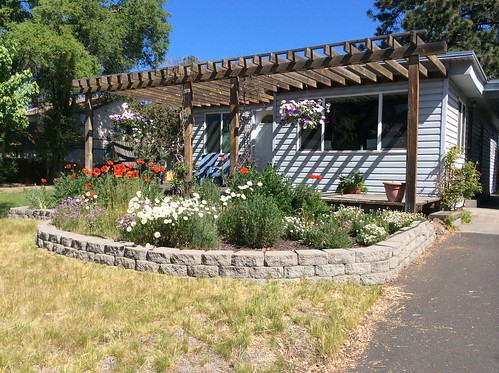July in the Garden
Gardening Insights for the Mohawk Valley (Zone 5)

Watering is the practice of gentleness.
– Michael P. Garafalo
What could be better than your garden as a place to unwind after a day at work, surrounded by beauty. Sit in a shady spot in the garden. Breathe deeply of your garden’s fragrances and enjoy the kaleidoscope of sights- all there because of your work.
PLANNING
Look around your garden and ask yourself a few questions. Could your garden use a little more character A birdbath? A trellis or two? Garden centers and many other places offer things to fit many a style. What’s yours? Summer art and craft fairs offer a rich bounty of unique items for the garden. A bench? Potted plants or flowers? Have a garden party and exchange ideas with your gardening friends this month.
THINGS TO DO IN EARLY JULY
- In New York State, July is usually a hot month and plants that are not heat and drought tolerant tend to show this by their wilting foliage. Water often and thoroughly in the morning to encourage deep root growth and allow plant leaves to dry off during the day. If you’re not sure how much water to give your plants, dig down 2-3 inches into the soil after you’ve watered to see if the water is reaching the plants’ roots. One of the biggest mistakes gardeners make is watering too lightly too often. When this happens, the plants form most of their roots close to the soil surface instead of reaching down into the soil where consistent moisture is available, making them more drought prone.
- If needed, where it is thin, add more mulch to retain ground moisture. If the mulch has started to crust over, loosen and fluff it up so water can permeate it and get down into the soil.
- Containers need frequent watering, especially those in full sun. They may also need a good trimming by the time in the season. Cut straggly plants back now and they should put out fresh new growth and blossoms in just a couple of weeks. The same is true for the perennials growing in the landscape.
- Pull weeds while they are small and before they set seed. Otherwise they will multiply rapidly.
- Stop pinching back your mums and asters by July 4th to allow them to form buds by the fall. Fertilize them these plants by the end of the month.
- Continue to stake taller plants and train vines as they grow.
THINGS TO DO IN MID JULY
- Deadhead spent flowers regularly.
- Watch for insect or disease damage and take immediate action to control it. Be sure to identify the problem before choosing an appropriate, hopefully benign, insecticide. Cornell University’s extension office can help you diagnose problems and advise treatment.
- If you’re seeing signs of slug damage on your hostas, try pinching off the lower leaves that lay on the ground to keep slugs from using them as ramps to climb into the plant. This also gives the plant a nice upright look.
THINGS TO DO IN LATE JULY
- Divide and replant Bearded Iris rhizomes this time of year. These plants generally need dividing every 3 to 4 years. Dig up the entire clump and discard the old, woody rhizomes in the center of the clump. Separate the rhizomes growing around the edge of the clump into single fan sections. With a clean pair of scissors or clippers, cut the foliage back to about 5 inches tall.
- Replant these individual rhizomes in groups of 3 in a sunny, well-drained location. Be sure to leave the top of the rhizome exposed above the soil to avoid rot. Chances are, you’ll have plenty of extras to share with your fellow gardeners or to put in a new Iris bed elsewhere in your garden.
Categories
Recent Posts

CB Faith Broker







